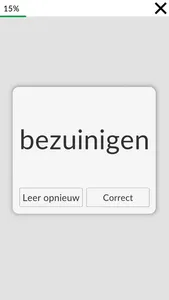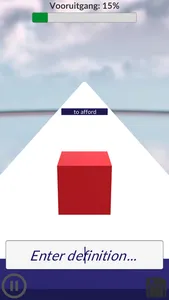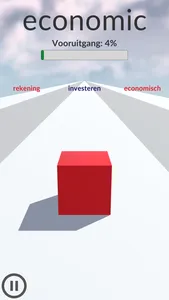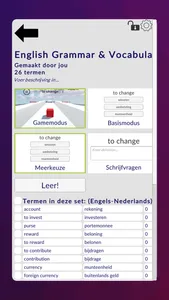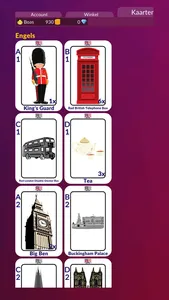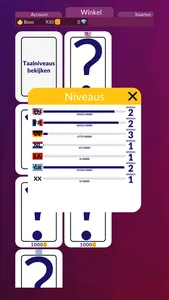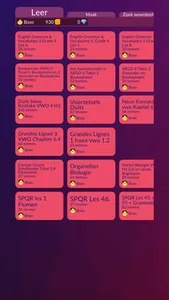TermLearn is a language learning app designed to make the process of learning new words engaging and fun. It offers users two different modes of learning: Game Mode and Basic Mode, as well as three answer modes: Writing Questions, Multiple Choice Questions, and Flashcards. The app can be used not only for learning languages but also for mastering concepts, definitions, and abbreviations in any subject.
Taking inspiration from other games, you can earn coins by learning words, which you can spend on buying cards. For each language there are quartets related to the country corresponding to the language.
The user can also highly customise how the game is played, so the learning is as effective as possible. Currently 6 languages are added: English, French, German, Dutch, Latin and Ancient Greek, but you can also use it to learn other languages or subjects.
Basic Mode is the simpler of the two modes and is better suited for slower devices. There is no time limit, and there is no score. In contrast, Game Mode is a more engaging mode of learning that immerses the user in a game-like experience. In this mode, the user controls a cube and must navigate it through obstacles to avoid collisions. This mode offers a more interactive learning experience and is more suitable for those who prefer a more engaging learning experience.
The three answer modes offer different ways to practice and reinforce new vocabulary. In Writing Questions, the user must type out the answer to a given word before hitting an obstacle. In Multiple Choice Questions, the user must select the correct answer from a list of options. Flashcards, the third answer mode, is only available in Basic Mode. In this mode, the user must think of the correct answer in their mind and indicate whether they were right or wrong. This mode is a great for if you want to learn fast on mobile devices, where typing can be very slow.
In the main menu, there are seven tabs available: Learn, Create, Search Sets, Settings, Account, Shop, and Cards. The Learn tab shows all the word sets the user has, sorted by when they last learned them. If the user has more than four sets, the sets will be organised by language. The user can click on a set to see the set menu for that set, and right-click to delete the set.
The Create tab is where the user can create a word set. The user can enter a title, description, and the words they wish to learn. Each term has one line, and the term and its definition are separated by an equal sign. In the settings, the user can edit the separator characters, whether the set is public or private, and the left and right language. There is also a button to create a set from the set data the user has copied.
The Search Sets tab displays a list of users who have made public sets, sorted by how many sets they have made. The user can click on a user to view the sets made by that user. This feature is currently a temporary solution, and the developer plans to implement a search system in the future that allows users to search for sets based on language, subject, grade, chapter, and other criteria.
The Settings tab allows the user to change some settings.
The Account tab is for all things account related, including changing your username, profile picture, password, and more.
In the Shop tab you can buy cards and view which level you are in each language. In the cards tab you can see the cards you have collected so far. Cards are organised into quartets of 4 cards, each quartet has a theme, like tourism, buildings, people, mythology or cuisine. The goal is to collect all cards from the quartets. You can buy cards with coins, which you get by learning words. For 1000 coins you can get a random card from a specific language. For each coin you get you also get one xp point in the language you are learning. When you get 10000 xp points you reach level 2, and you unlock a new quartet.
Taking inspiration from other games, you can earn coins by learning words, which you can spend on buying cards. For each language there are quartets related to the country corresponding to the language.
The user can also highly customise how the game is played, so the learning is as effective as possible. Currently 6 languages are added: English, French, German, Dutch, Latin and Ancient Greek, but you can also use it to learn other languages or subjects.
Basic Mode is the simpler of the two modes and is better suited for slower devices. There is no time limit, and there is no score. In contrast, Game Mode is a more engaging mode of learning that immerses the user in a game-like experience. In this mode, the user controls a cube and must navigate it through obstacles to avoid collisions. This mode offers a more interactive learning experience and is more suitable for those who prefer a more engaging learning experience.
The three answer modes offer different ways to practice and reinforce new vocabulary. In Writing Questions, the user must type out the answer to a given word before hitting an obstacle. In Multiple Choice Questions, the user must select the correct answer from a list of options. Flashcards, the third answer mode, is only available in Basic Mode. In this mode, the user must think of the correct answer in their mind and indicate whether they were right or wrong. This mode is a great for if you want to learn fast on mobile devices, where typing can be very slow.
In the main menu, there are seven tabs available: Learn, Create, Search Sets, Settings, Account, Shop, and Cards. The Learn tab shows all the word sets the user has, sorted by when they last learned them. If the user has more than four sets, the sets will be organised by language. The user can click on a set to see the set menu for that set, and right-click to delete the set.
The Create tab is where the user can create a word set. The user can enter a title, description, and the words they wish to learn. Each term has one line, and the term and its definition are separated by an equal sign. In the settings, the user can edit the separator characters, whether the set is public or private, and the left and right language. There is also a button to create a set from the set data the user has copied.
The Search Sets tab displays a list of users who have made public sets, sorted by how many sets they have made. The user can click on a user to view the sets made by that user. This feature is currently a temporary solution, and the developer plans to implement a search system in the future that allows users to search for sets based on language, subject, grade, chapter, and other criteria.
The Settings tab allows the user to change some settings.
The Account tab is for all things account related, including changing your username, profile picture, password, and more.
In the Shop tab you can buy cards and view which level you are in each language. In the cards tab you can see the cards you have collected so far. Cards are organised into quartets of 4 cards, each quartet has a theme, like tourism, buildings, people, mythology or cuisine. The goal is to collect all cards from the quartets. You can buy cards with coins, which you get by learning words. For 1000 coins you can get a random card from a specific language. For each coin you get you also get one xp point in the language you are learning. When you get 10000 xp points you reach level 2, and you unlock a new quartet.
Show More

